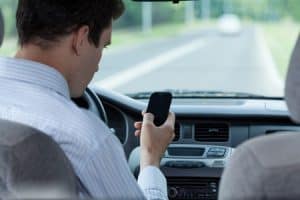[profileleft] [/profileleft]Generally, when society identifies and almost uniformly agrees that a behavior is dangerous, people tend to respond by avoiding that behavior as much as possible. The past several years have seen more and more information coming out with regards to using mobile phones while driving. A vast majority of jurisdictions in the United States now either ban their use altogether or substantially limit the ways in which they can be used by motorists. Survey after survey has revealed that motorists understand the threat of distracted driving accidents that result from using phones. Given all of this, one would think that the use of smartphones while driving would be going down. According to a recent survey, the opposite appears to be true. More people using smartphones while driving leads to more distracted driving accidents and higher insurance premiums.
[/profileleft]Generally, when society identifies and almost uniformly agrees that a behavior is dangerous, people tend to respond by avoiding that behavior as much as possible. The past several years have seen more and more information coming out with regards to using mobile phones while driving. A vast majority of jurisdictions in the United States now either ban their use altogether or substantially limit the ways in which they can be used by motorists. Survey after survey has revealed that motorists understand the threat of distracted driving accidents that result from using phones. Given all of this, one would think that the use of smartphones while driving would be going down. According to a recent survey, the opposite appears to be true. More people using smartphones while driving leads to more distracted driving accidents and higher insurance premiums.
About the Smartphone Prevalence Study
State Farm Mutual Automobile Insurance Co. conducted the survey. The company had an outside panel conduct these annual surveys of adults every year between 2009 and 2015. More than 1,000 people responded. Each of the respondents had some insurance coverage and some financial responsibility for their households. The survey involved several different aspects of driving, particularly as it dealt with the use of smartphones. What’s worse is that most of the distracting behaviors appear to be more common in 2015 than they were in 2009.
Below are 10 distracting behaviors and the percentage of drivers who admitted to engaging in these behaviors in 2009 and in 2015. The trend that is uncovered is troubling.
| Distracting Driver Behavior | 2009 | 2015 |
| Talk on a handheld phone | 65 percent | 51 percent |
| Talk on a hands-free phone | 42 percent | 55 percent |
| Text message | 31 percent | 36 percent |
| Listen to navigation system/GPS | 41 percent | 73 percent |
| Program navigation system/GPS | 30 percent | 51 percent |
| Access Internet on phone | 13 percent | 29 percent |
| Read email on phone | 15 percent | 23 percent |
| Respond to email on phone | 12 percent | 18 percent |
| Read social media networks | 9 percent | 21 percent |
| Update social media networks | 9 percent | 16 percent |
Of the 10 distracting behaviors listed, only one of them – talking on a handheld phone while driving – went down in prevalence between 2009 and 2015. That could be because some states have enacted laws specifically dealing with handheld phones. It could also be because more phones now come equipped with some sort of hands-free technology. In addition, more of them can be integrated with a vehicle’s software. Regardless, every other dangerous activity was more common in 2015 than it was six years earlier. The fact that 88 percent of those surveyed in 2015 owned a smartphone as compared to just 52 percent in 2011 is also a likely factor in the rise in dangerous driving and distracted driving accidents across the United States.
Distracted Driving Accidents – Potential Deterrents
The survey also asked respondents to list circumstances that would prompt them to stop reading and/or responding to text messages while driving. Below you’ll find the 10 most common circumstances listed in order of percentages:
- I cause a crash – 48 percent
- Financial/legal consequences – 42 percent
- Getting caught by police – 36 percent
- Wanting to be a good driving role model – 30 percent
- Someone I know causes a crash – 22 percent
- Penalty from employer – 18 percent
- Hearing/seeing a sad story about a text-caused crash – 17 percent
- The law as it exists – 13 percent
- A family member tells me to stop doing this – 10 percent
- Don’t know – 5 percent
Based on this data, if 100 of the respondents to this survey caused distracted driving accidents because they were reading or sending text messages, fewer than half of them would stop texting and driving. Those who would like to read the entire report from State Farm Insurance can find a link to a PDF download here.
How a San Diego Car Accident Lawyer Can Help
You’ll also notice that second on the list of deterrents is the possibility that drivers will face legal liability if they cause distracted driving accidents because they are texting. Even if the law does not act as a widespread deterrent – and the responses above reveal that only 13 percent of respondents believe they are – legal accountability is something that people seem to understand. For people in this area, this is one of the benefits of having a San Diego car accident lawyer available to help you if you are injured in this type of a crash. More than three times as many people involved in this survey fear legal liability than a possible citation from police when texting and driving.
That means that we need to do our part as private citizens to bring more people to a point where they no longer think that texting and driving is worth the risk. If you or someone you love has been injured in a crash that was caused by someone who was texting at the time, you need to make sure you do everything you can to hold that person accountable. You can do so by obtaining the help of San Diego car accident lawyers who have been fighting for the rights of injured clients for more than a decade. Contact Gomez Trial Attorneys today for a free case evaluation.








 How can I help you?
How can I help you?